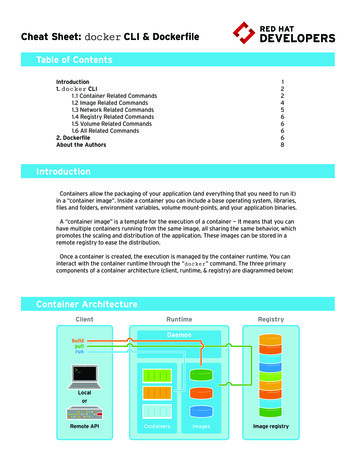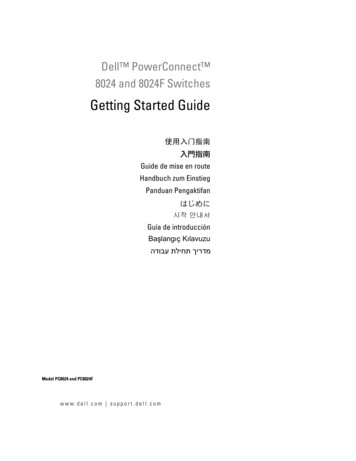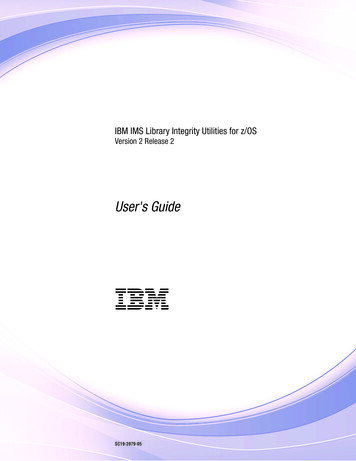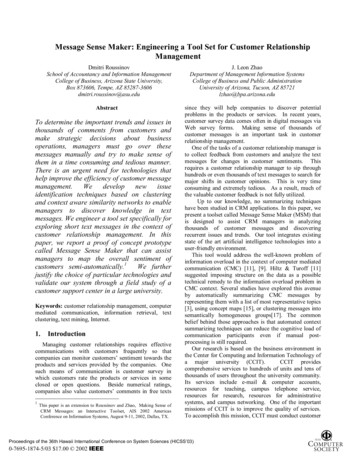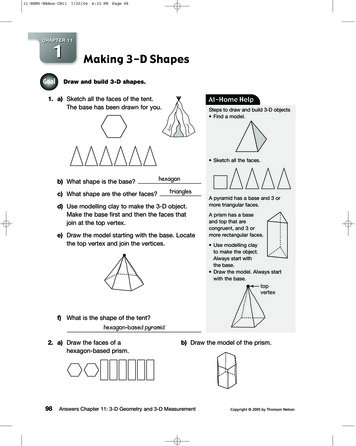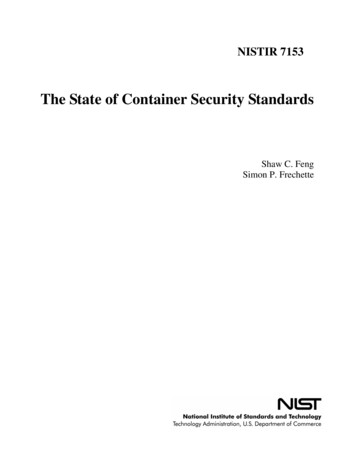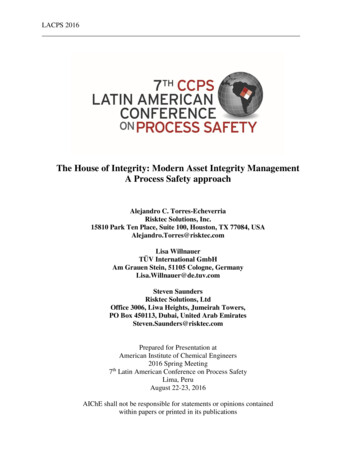
Transcription
Container ClosureIntegrity Testing (CCIT)Solutions for thepharmaceutical industry
The quality and effectiveness of drugs significantly depends on their proper packaging:Sterile products and moisture/oxygen sensitivedrugs require excellent barrier during the shelflife of the product (up to a couple of years) toprotect them from biological contamination,water and oxygen ingress. Otherwise, seriousconsequences might occur. This was provenby a grave incident in the 1970's: During thisperiod, contaminated intravenous fluids packaged in glass bottles – which were typical atthe time for packaging such dosage forms –caused an estimated 2,000 to 8,000 episodesof bloodstream infection, resulting in thedeaths of about 10 % of the patients. Thissevere package-integrity failure incident hastriggered a heightened awareness of packageintegrity in the life science industry.The key risks for contamination are by humidity, oxygen ormicrobiological ingress, which can impact the drug stabilitythroughout the product life cycle. To prevent the risks of stability failure of highly moisture sensitive drugs (e.g. dry powderfor inhalation) or the risk of biological ingress of sterile parenteral drugs, integrity tests with a high sensitivity are required.1207.1: Package Integrity and Test Method Selection1207.2: Package Integrity Leak Test Methods 1207.3: Package Seal Quality Test MethodsThe USP 1207 thereby does not claim to describe all possible methods, but gives a good overview and general guidelinefor the evaluation of various popular potential methods. Test methods and detection limitsAn initial list of the various test methods used for packageintegrity testing was already published in the late 90s. The reportback then was very narrow inrequire packagingscope and recommended to valifor prevention of moisture ordate chemico-physical leak testby comparing themIn 2008 the US FDA published aoxygen or microbial contamination methodsdirectly to a microbiological ingressnew guideline for the whole life scitest. This probabilistic test methodence industry (pharmaceutical comrelies on a series of sequential and/panies, veterinarian drugs and comor simultaneous events with random results. The findings arepanies that manufacture sterile medical products) that obligesthe sector to perform reliable physical measurement to ensure associated with uncertainties that demand large sample sizesand precise test condition controls. Some publications onproper CCI.microbiological ingress tests show that the method detectsleakage pathways the size of a single microorganism. TheIn practice, the regulations of the FDA as well as the European Guideline for Good Manufacturing Practice with Annex 1for the Manufacture of Sterile Medicinal Products are often100interpreted quite broadly and without specific recommenda80tions. The main obligation given to the manufacturers is thatthey must ensure “the container-closure system to maintain60the integrity of its microbial barrier, and, hence, the sterility ofa drug product throughout its shelf life” (US FDA).What the official regulations often do not describe in detail ishow the CCI testing should be performed. They usually onlystipulate to use appropriate methods and procedures. TheUnited State Pharmaceopia, the government body in-chargeof standards and guidelines for the pharmaceutical industry –which typically are internationaly accepted – dealt withthis issue and in 2016 presented a new guideline: theUSP 1207 . This guideline focuses on sterile and criticalpharmaceutical products (e. g. vials and syringes) and isdivided into 3 chapters:2Microbial Ingress Failure Rate (%)Regulated marketThe high risk in regards to pharmaceutical Container ClosureIntegrity Testing leads to a strictlyregulated environment. Key authorities are the FDA (United States) andSensitive drugsthe EMA (Europe).40200-7-6-5-4-3-2-1Log orifice sizeMean leakdiameter (microns)0.10.20.30.40.7268Figure 1: Microbial ingress failure rate in relation to leak size(source: Kirsh, PDA J Pharm Sci & Technol, 54,4, 2000 p. 305-314)
below chart describes the risk related to different orifice sizes:As shown in figure 1, the critical leak size is at 0.2 µm,respectively 6·10-6 mbar l/s. This value is widely used as theso-called MALL (maximum allowable leak level). Furthermore,the chart says that a leak of 2 µm already poses a risk ofclose to 70 % for the contamination of the drug.This must be kept in mind when looking at other studies,which have proven that classical probabilistic test methodscould miss leaks, resulting in an impairment of product sterility. Specific examples are Microbiological Ingress Testing aswell as Blue Dye Test Methods.Detection probability(%) of vials with dye ingress100SolidfilledRigidpackagingFigure 5: Drug/container configuration matrix40dye ingressmicrobial ingress2020304050607080Microtube inner diameter (µm)Figure 2: Detection probability in relation to microtube innerdiameter (source: Burrell L.S. (et. al PDA J Pharm Sci Tech 54,p. 449-455), Figure 3)As shown in figure 2, a dye ingress test has only an about70 % chance to detect a 10 µm leak. Any leaks below 5 µmare more or less non-detectable.It is therefore recommended to apply a deterministic integritytest method whenever leakage measurements are based onphenomena that follow a predictable chain of events. TheLeak test methodMeasurementoutcomeRow DetectionrangeTracer gas(Helium massspectrometry)Helium flow(mbar l/s)1 0.1 to10 µmLaser-Headspace(Frequenzy modulatedspectroscopy)[O2] and/or [CO2]Gas pressure(%)2 0.1 to 50 µmAMI1(Optical emissionspectroscopy)Leakage (N2, Ar,CO2, H2O.)(mbar l/s)21 0.2 to 50 µmMass Extraction(Micro/Mass flowsensors)Mass flow(µg/min)32 1.0 to 50 µmHVLD(Leakage current)Electrical current(µA)3 1.0 to 50 µmVacuum decayPressure rise(mbar/s)3 1.0 to 50 µmUSP 1207 "Emerging Technology" ASTM Standard F-3287-17 proves capability to detect 1.0 µm defect,qualifies for USP 1207 row to ratingFigure 4: Overview of different leak test methods5Liquidfilled600102The broad range of different methods can be traced back tothe different challenges for CCIT within the pharma market.Those are related to the different process steps, the differentpackaging types and the different drug types.Flexiblepackaging8001chart below gives an overview of corresponding deterministictest methods, mainly based on PDA USP 1207 :While in the early development stage of a packaging (“packaging design phase”), the supplier is obliged to ensure thatthe packaging is by design capable to ensure the sterility.Therefore the packaging needs to be tested for defects in therange of 0.2 µm, respectively 6 · 10-6 mbar l/s (MALL). Theseare the current requirements for stability and quality control ofcontainers filled with drugs. Integrity tests are mainly performed in the range of 2 to 20 µm defect size. The main reason for this is the feasibility of the available methods to detectsmaller defects in a reasonable test time. When dealing with a100 % inspection of the production line that operates atspeeds for 120 to 600 parts per minute, the allowed defectsize is sometimes even increased to a significantly higher level. The Limit of Detection (LOD) for production units is definedas a risk-based decision between cost, technology and product. To compensate on this risk-based approach, additionaloff-line sample testing is performed to a tighter spec in therange of 1 to 10 µm. This also applies to stability testingwhich is performed in laboratory tests. Here again the sensitivity is more important than the test time.Figure 5 gives a rough differentiation between the broadrange of different packaging and drug types within thepharma industry. Not all test methods can be used for allkinds of packaging as well as all drug types.Besides the below-mentioned characteristics of packagingtypes, also characteristics such as transparency of the packaging and its electrical conductivity play an important part inregards to the selection of the right integrity test method.Table 1 below gives a more detailed overview of availableCCIT methods and also provides as a guideline for theselection by pointing out specific characteristics as well aslimitations of the different test methods:Pfeiffer Vacuum test methodsPfeiffer Vacuum offers a wide range of different leak testingmethods to adress the multitude of challenges within thepharmaceutical industry as there is no one solution that fitsall different challenges connected to a specific product.Pfeiffer Vacuum can support you during the complete CCITprocess definition and integration and also provide GMP support in regards to IQ/OQ (Installation Qualification/OperationalQualification) including the needed documentation for all ourtest methods. The following overview gives you an impressionof Pfeiffer Vacuum s portfolio of leak testing methods.
Helium tractionVacuumDecayYesYesYesYes(Yes)only for open containersYesYesYesYesYesYesYesQuantitativeSample preparationO.E.S (Optical EmissionSpectroscopy)He charging PlausabilitytestNo sample preparationTest pressureVacuumDetection range(Sharp edge orifice)0.01 Q 10 µm 0.2 µm 1 µm 5 µmLyophilized (dry) or liquid drugsDrug Product LimitationsPlugging risk for small defects for protein based drugsContainer must handle 1 bar differential pressureContainerLimitationsNon-porous materialHe PermeationHigh outgazingRequire gas headspace or liquid inside the containerDifficult to set-up Requires proper He gasmanagement Requires plausabilitytest to valid the testresult.MethodLimitationsNot practical for massproduction testingHigh selectivity (He)MethodAdvantagesCommentsOutgazing of the container and the drug type will impact thetest duration and the detection limitHigh sensitivity testDetection limit isdepending on packagingand drug typeFree volume inside the test chamber can limitsensitivity -- Test chamber must be optimizedfor each format parts.Detection limit dependson the gas used for thedetectionSensitive to temperature and/or volume variationsSelectivity: can detectsimultaneously gas species (N2, H20, Ar, CO2, )High sensitivity detectionof water leakageSimpleRobust technologyPossibility to localize theleak position with sniffing.Can test multiple containers with high sensitivity atthe same time.Mainly used for the designand qualification phaseof the packaging's,not practical for massproduction testing.Highly verstaile and sensi- Highly verstaile and sensi- Older production testtive test for different drug / tive test for different drug / method.packaging systemspackaging systemsReduced reliability forCan be used in laboratory In-line option available.measurements at limit ofor as IPC in production.detection.Table 1: Available CCIT methods and selection guidelineHelium Mass SpectrometryPfeiffer Vacuum helium leak detection solutions are perfectfor MALL testing in the pharmaceutical industry. In order toensure a correct measurement, it is very important to manage the tracer gas concentration during the measurement.This is especially tricky when handling vials or other sealedpackages. Therefore, Pfeiffer Vacuum offers complete solutions including tracer gas handling and charging, as well asadaptations for your packaging and test chambers.Figure 6: Leak detector for MALL testing from Pfeiffer Vacuum(Conceptionally design)3
Vision(Deflexion)HSA(Head Space Analysis)HVLD(High engeYesStorage timeNo sample preparationAtmospheric Pressure 5 µm 0.01 µmLyophilized drugsRigid & TransparentImmersion in dye or microbial mediaShallow VacuumAtmospheric Pressure10-40 µm 20 µm 0.2 µmConductive liquid drugsLight colored drugs–Non-conductivematerialNon-porous materialContainer Design(Semi-rigid or flexibe)Require gas headspaceSensitivity depends on theproduct design: Headpsace volume Size of the cavity Shape of the containerRequires waiting timebefore actual testing(hours up to weeks)Waiting time depends onthe gas headspace anddetection limit.Headspace needs tobe either vacuum or100 % NitrogenTest only at the point ofDestructiveelectrode contact, with liquid behind.ProbabilisticLimited usage for flexiblepackaging's.No real quantitative measurementLong (few weeks) andExpensivePoor sensitivityOperator & multiparameters dependantRisk due Ozone generationRequires positive control to calibrate the equipmentIdentification of the leakycavity or container.Can test multiple containers with high sensitivity atthe same time.Mainely used for blisterpacks.High selectivity (O2)Very fast, high thorughputcan be acheivedVery fast, high thorughputcan be acheivedIndirect leak test, wemeasure the consequenceof oxygen ingress throughdefects.Low cost equipmentDirect measurement of thebiological contaminationEasy to understandVery fast method for production test, limited usagefor flexible packaging's.Widely-used for decadesIndustry & regulatory familiarityMass ExtractionOur USP 1207 and ASTM (F-3287-17) recognized MassExtraction Technology works on the principle of rarefied gasflow. Testing takes place in vacuum conditions to attain highersensitivity. This patented technology type of testing is particularly suitable for pharmaceutical packaging such as IV-bags,pouches or glass vials. Larger defect and defects as small as1 μm can be detected with this method. The technology isthereby suitable for laboratory applications as well as for theuse in production environment allowing stability control aswell as automated 100 % testing (also in inline machines).FDA laboratories in the US and major pharmaceutical companies have been using the Mass Extraction instruments for over10 years.Figure 7: Mass Extraction system from Pfeiffer Vacuum4
Optical Emission SpectroscopyThe Pfeiffer Vacuum Optical Emission Spectroscopy Instrument used in the AMI test systems measures leak tightnessusing a patented process that does not require a tracer gas.Instead, this method uses the existing gas mixture in the cavities inside the packaging to perform high-sensitivity testingover an extended measuring range. Thereby the AMI has theability to differentiate gas species that are typical to pharmaceutical products. The procedure offers great flexibility andcan test a variety of different packaging types such as blisterpacks, pouches, vials and plastic bottles and can also testmultiple samples at the same time.The wide measuring range of the AMI offers higher sensitivitythan conventional tests, starting from 0.5 μm (and smaller)respectively leak rates of down to 1·10-6 mbar l/s, but can alsoidentify gross leaks as for example a completely open container. As a result, the AMI device can perform gross and fineleak testing in just one device. The procedure delivers deterministic test results with high repeatability, irrespective of theuser, and with reliability and accuracy that within the range ofFigure 8: Compact leak test system AMI from Pfeiffer VacuumUSP 1207.1. It can be used in laboratory testing as well asIPC (In Process Control) during production testing. Dependingon the packaging, also the simultaneous testing of multipleparts at the same time is possible.All data subject to change without prior notice. PI0479PEN (October 2018/1)VACUUM SOLUTIONS FROM A SINGLE SOURCEPfeiffer Vacuum stands for innovative and custom vacuum solutions worldwide,technological perfection, competent advice and reliable service.COMPLETE RANGE OF PRODUCTSFrom a single component to complex systems:We are the only supplier of vacuum technology that provides a complete product portfolio.COMPETENCE IN THEORY AND PRACTICEBenefit from our know-how and our portfolio of training opportunities!We support you with your plant layout and provide first-class on-site service worldwide.Are you looking for aperfect vacuum solution?Please contact us:Pfeiffer Vacuum GmbHHeadquarters · GermanyT 49 6441 802-0www.pfeiffer-vacuum.com
the different challenges for CCIT within the pharma market. Those are related to the different process steps, the different packaging types and the different drug types. As shown in figure 2, a dye ingress test has only an about 70% chance to detect a 10 µm leak. Any leaks below 5 µm are more or less non-detectable.
